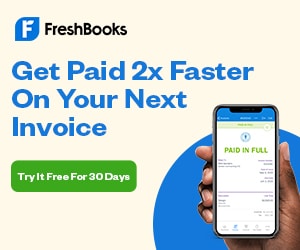Let’s be honest—selling is not fun and games. As a freelancer, your income is largely dependent on it. It can be stressful and even daunting, often considered the least appealing task on your to-do list. Here’s my short list of activities to make selling as pleasant as possible—for you and your customers!
1. Why Should You Listen to Me?
I’ve been selling for almost two decades, which is quite a long time considering I’m 34 years old. In my early days, I did telemarketing and even door-to-door selling. Later on, I sold complex software products to banks, corporations, and even the government.
I’ve also sold my company and raised millions for a pre-revenue startup. So, I’ve had plenty of experience selling to both consumers and large enterprise customers. Here are a few lessons I’ve learned, and I guarantee they will help you as a freelancer.
And this structure has actually helped me to enjoy those conversations – or should I say sales meetings.
Money Note: If an extra $1K–$5K/month would change your 2026 goals (debt, savings, travel, freedom), you’ll want to catch this: free live workshop from a freelancer who’s earned $4M+ online. No fluff. No gimmicks. A real roadmap. 👉 Watch the training or save your seat here »
These are my secrets disclosed, for the first time.
2. Establish a Safe and Neutral Environment
Key Message: The foundation of any successful sale is the customer’s willingness to share opposing opinions. Most of the time the dialogue ends when the customer says “I need to think about it”, and often that is not the case.
How to do that?
You can create this safe and neutral environment by asking certain questions and disclosing something about yourself so that it feels natural for your clients to share similar information about themselves. It’s how people are wired. If you just bombard the customer with questions, it will feel more like an interrogation than a pleasant, normal conversation.
I often kick things off by introducing myself and always sharing something personal to show vulnerability. You get what you give in sales, as in life. You need to be open so customers can be open about their situation as well.
For example, I recently started at SparkReceipt (AI-powered pre-accounting/expense tracker for freelancers), so my introduction to an important client might go something like this:
“Hi, to introduce myself, I’m Joel, living in Helsinki with my spouse and our one-year-old boy. I like to golf and cycle in my spare time, and I’m a very enthusiastic music lover. I must say, I’m not an expert with this product and company yet. I just started and am still learning. I just wanted to say this if you wonder why I might not have all the answers to your questions. But that’s about me, tell me a bit about yourself—I’d love to hear how you ended up being a freelancer.”
Now that I’ve shared something personal about myself, it feels natural for the customer to do the same. And you can ask questions and it feels normal.
3. Set Ground Rules for Honest Communication
Key Message: Agree on rules that encourage honesty and transparency from the start.
You need to get the most honest opinions from your customers. Before diving into the specifics of your product or service, establish a mutual understanding that honesty is key. If a client says they need time to think, it often means they have reservations they’re not voicing. Address this directly by saying:
“I’m not here to push you into anything. I’m genuinely interested in your thoughts on our product. If something doesn’t feel right, I want to hear about it. Would you agree to be upfront with me, so we don’t waste each other’s time? How would you feel about this?”
To prevent ghosting after the first meetings, I often say:
“I always keep my promises, so if I promise to deliver something or answer a question, I’ll do so within the agreed timeline. How does this sound to you? If we move forward, would you promise to do the same for me?
This is very important so you don’t get ghosted. It is better to get a No than not hearing honest opinions and ending up with another round of meetings with a customer who is not buying. You can also refer back to this verbal agreement in the future.
You can then conclude with:
“I’m just interested in your thoughts, and I won’t take them personally, so you can criticize our product as much as you want. Does that sound okay to you?”
Often in sales, honest or opposing opinions are not heard, which makes it difficult to have a meaningful dialogue. Why is that? Everybody knows the pattern in sales meetings when you try to criticize something or tell an opposite opinion, the salesperson argues back without even listening. That is the key reason we fail in sales.
4. Ask the Right Questions to Focus the Conversation
Key Message: Use targeted questions to guide the conversation and ensure the client sees the relevance of your product.
Now that you’ve created a space where the customer feels safe to share their honest thoughts, you can proceed. As said, negotiation stalls when the customer is not disclosing their true issues. By spending time building rapport in the beginning, customers won’t be afraid that you’re just selling instead of listening.
The next step is to ask a ton of questions to determine if your solution is ideal for the customer. These questions help bring the topic to the forefront of the customer’s mind. When moving toward the demo, the customer must feel that this topic is relevant and important to them. Without this pre-work, you risk losing the customer’s attention during the demo, leaving you essentially presenting to a brick wall.
When I sell to customers in SparkReceipt, my questions would be:
- What is important to you when choosing a pre-accounting application?
Rationale: This helps me understand what’s important to the customer and allows them to articulate it for themselves. - What is the key benefit you’re looking for?
Rationale: Same as above. - What experiences have you had with expense trackers in the past?
Rationale: This is an important question to understand whether they have positive or negative experiences on the topic.
These questions help you gather valuable feedback while keeping the conversation open-ended. It’s far more effective than the traditional “Do you want to sign up?” which often leads to a vague “I need to think about it.”

5. Conduct a Meaningful Demo and Close with Confidence
After the demo, it’s natural to ask:
- How did you like it?
- What got you excited? What didn’t?
- How and when are you making the decision?
- How would you like to move forward?
These questions help you gather valuable feedback while keeping the conversation open-ended. It’s far more effective than the traditional “When can we start?” which often leads to a vague “I need to think about it.”
Conclusion: Your Blueprint for Sales Success
This structure is not just a method—it’s a mindset. By creating a safe space, setting clear expectations, asking the right questions, and conducting a meaningful demo, you transform selling from a stressful task into a rewarding experience. Use this as a template and adapt it to fit your style. And remember, tools like SparkReceipt can take the hassle out of accounting, freeing you to focus on what you do best—growing your business and exceeding customer expectations.

Keep the conversation going...
Over 10,000 of us are having daily conversations over in our free Facebook group and we'd love to see you there. Join us!


